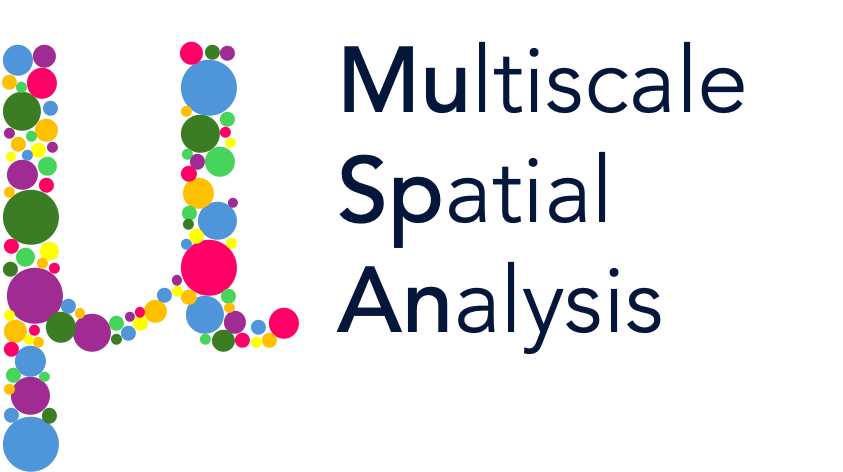quadrat_correlation_matrix#
- quadrat_correlation_matrix(domain, label_name, population=None, include_boundaries=None, exclude_boundaries=None, boundary_exclude_distance=0, regions_collection_name=None, regions_label_name=None, region_method='quadrats', region_kwargs={}, keep_regions_as_objects=False, verbose=False, max_iters_for_singular_matrix_encounter=1000, alpha=0.05, transform_counts=None, low_observation_bound=15, visualise_output=False, visualise_correlation_matrix_kwargs={})#
The Quadrat Correlation Matrix (QCM) identifies statistically significant co-occurrences between objects with different labels (e.g., cell types) within regions of interest (ROIs). It compares the observed correlation between pairs of labels against the expected correlation under random label assignment.
Regions can be generated using quadrats, hexagonal grids, or pre-defined labels in the domain (specified via the regions_label_name parameter). If no regions are provided, quadrats with a specified side length (via region_kwargs) will be generated.
- Parameters:
- domainobject
A muspan domain object.
- label_namestr
The name of the label used to calculate the QCM.
- populationquery-like, optional
Specifies the population of objects to include in the QCM. Can be a list or array of object indices, a muspan query, or None to include all objects. Default is None.
- include_boundariesquery-like, optional
Specifies external boundaries within which to perform the QCM. Can be a list or array of object indices, a muspan query, or None to use the entire domain. Default is None.
- exclude_boundariesquery-like, optional
Specifies internal boundaries (excluded regions within the shapes defined by include_boundaries). Can be a list or array of object indices, a muspan query, or None. Default is None.
- boundary_exclude_distancefloat, optional
Buffer distance to exclude objects located near boundaries. Default is 0.
- regions_collection_namestr, optional
Name of the regions collection to use. Default is None.
- regions_label_namestr, optional
Name of the label used to assign objects to regions. Default is None.
- region_methodstr, optional
Method to generate regions if no collection or label name is provided. Options are ‘hexgrid’ or ‘quadrats’. Default is ‘quadrats’.
- region_kwargsdict, optional
Additional keyword arguments for region generation. Default is an empty dictionary.
- keep_regions_as_objectsbool, optional
Whether to keep regions as objects if they are constructed by this function. Default is False.
- verbosebool, optional
Whether to print verbose output during execution. Default is False.
- max_iters_for_singular_matrix_encounterint, optional
Maximum number of attempts when encountering a singular matrix. Default is 1000.
- alphafloat, optional
Significance level for statistical tests. Default is 0.05.
- transform_countsstr, optional
Transformation to apply to counts. Options are ‘arcsinh’, ‘log’, ‘sqrt’, or None. Default is None.
- low_observation_boundint, optional
Labels appearing fewer than this number of times in the population will be excluded from analysis. Default is 15.
- visualise_outputbool, optional
Whether to visualise the correlation matrix. Default is False.
- visualise_correlation_matrix_kwargsdict, optional
Additional keyword arguments for visualising the correlation matrix. Default is an empty dictionary.
- Returns:
- SESnumpy.ndarray
The standard effect size matrix. Positive values indicate increased correlation compared to random relabelling, while negative values indicate decreased correlation.
- Anumpy.ndarray
The filtered quadrat correlation matrix. A subset of the SES matrix showing only statistically significant associations (after Benjamini-Hochberg correction).
- label_categoriesnumpy.ndarray
The label categories corresponding to the rows and columns of the SES and A matrices.
- Raises:
- RuntimeError
If the label name is not found in the domain’s labels.
- RuntimeError
If the label is not categorical.
- RuntimeError
If too many singular matrices are encountered during computation.
Notes
Any shapes can be used as regions for cell counts. To implement this, use a pre-defined collection of regions containing label_name labels and pass this collection using regions_collection_name.
References
For more information on the method, see Morueta-Holme et al. (2016).
Examples
A range of related tutorials and examples:
